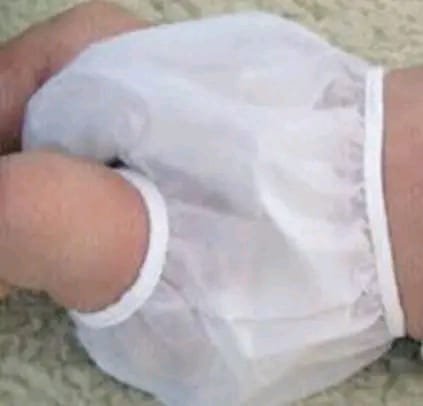The Evolution of Baby Clothing: A Look at Traditional and Modern Diaper Covers

ADVERTISEMENT
The Evolution of Baby Clothing: A Look at Traditional and Modern Diaper Covers
Introduction
For centuries, parents have sought the most comfortable, practical, and hygienic clothing options for their babies. Among these essential garments, diaper covers have played a crucial role in keeping babies clean and comfortable while preventing leaks. The image above depicts a classic white, sheer diaper cover, a style that was popular in many households before the advent of modern disposable diapers and waterproof covers. These soft and breathable covers provided both functionality and charm, offering a gentle and stylish solution for babies. In this article, we will explore the history, benefits, and evolution of baby diaper covers, comparing traditional designs with today’s innovative options.
The History of Diaper Covers
Diapering methods have evolved significantly over time. In the past, before the invention of disposable diapers, parents relied on cloth diapers secured with pins and diaper covers made from different materials. Some of the earliest diaper covers were crafted from:
- Cotton or muslin for breathability and comfort.
- Wool for its natural absorbency and moisture-wicking properties.
- Rubberized or plastic fabrics to prevent leaks and keep clothes dry.
By the mid-20th century, sheer nylon or organza covers, similar to the one in the image, became a popular choice. These covers were lightweight, comfortable, and often used for special occasions, ensuring that babies looked cute and neat while staying protected.
Traditional Diaper Covers: Function and Style
Traditional diaper covers were not just about functionality; they were also designed to be aesthetic and practical. Some of their key benefits included:
✅ Softness and Comfort – Made from lightweight fabrics, they were gentle on a baby’s delicate skin.
✅ Breathability – Unlike plastic diaper covers, these allowed air circulation, reducing the risk of diaper rash.
✅ Elegance – Often designed with frills or embroidery, they added a classic touch to baby outfits.
✅ Reusable and Eco-Friendly – These covers could be washed and reused multiple times, making them an environmentally friendly option compared to disposable diapers.
ADVERTISEMENT
Parents often layered these covers over cloth diapers, ensuring that babies remained comfortable while reducing leaks. Though they lacked waterproof protection, they were ideal for short periods and indoor use.
Modern Innovations in Baby Diaper Covers
With advances in textile technology and baby care, modern diaper covers have come a long way. Today, parents can choose from:
🔹 Waterproof Diaper Covers – Made from PUL (polyurethane laminate) or fleece, these covers prevent leaks while being breathable.
🔹 All-in-One Diapers – Featuring built-in waterproof layers, these eliminate the need for separate covers.
🔹 Organic Cotton and Bamboo Covers – Providing extra softness while being free from harsh chemicals.
🔹 Velcro and Snap Closures – Making diaper changes quicker and easier compared to old-fashioned safety pins.
While modern diapering solutions prioritize convenience, many parents still appreciate traditional styles for their vintage charm, elegance, and sustainability.
Conclusion
Diaper covers, like the one shown in the image, remind us of a simpler time in baby care, when comfort, breathability, and aesthetics were top priorities. While modern advancements have introduced more efficient and leak-proof diapering methods, traditional designs still hold a special place in many households. Whether you’re a fan of classic diaper covers for their nostalgic appeal or prefer modern innovations for convenience, it’s clear that baby clothing has continuously evolved to balance functionality, comfort, and style.
ADVERTISEMENT




